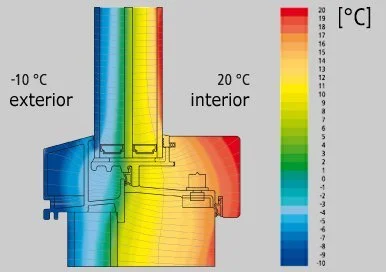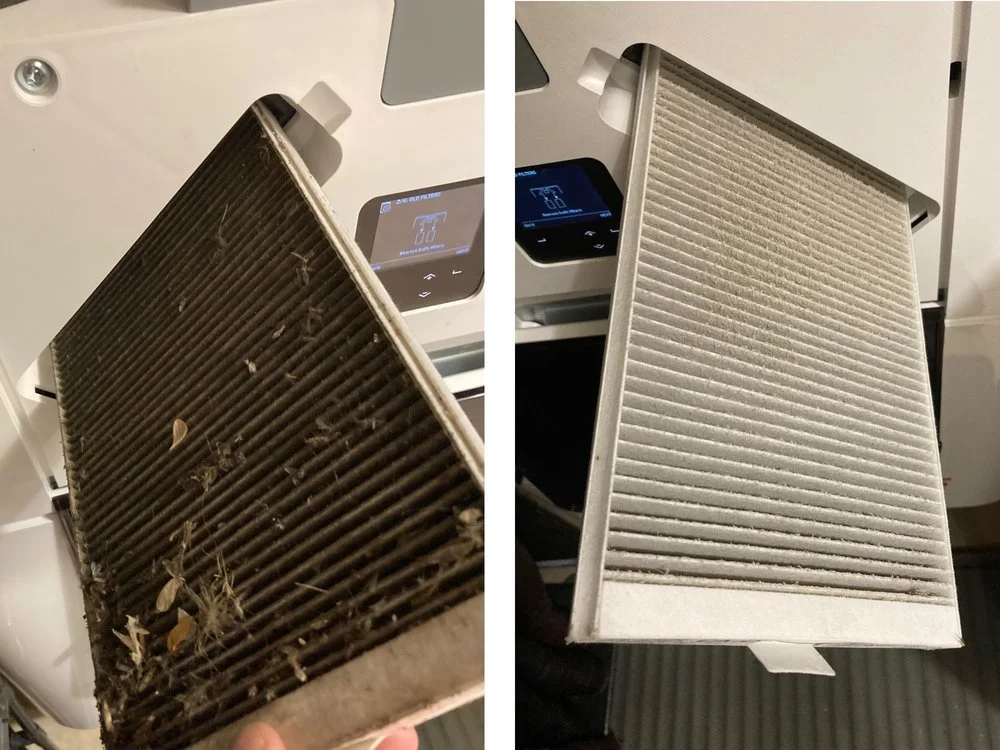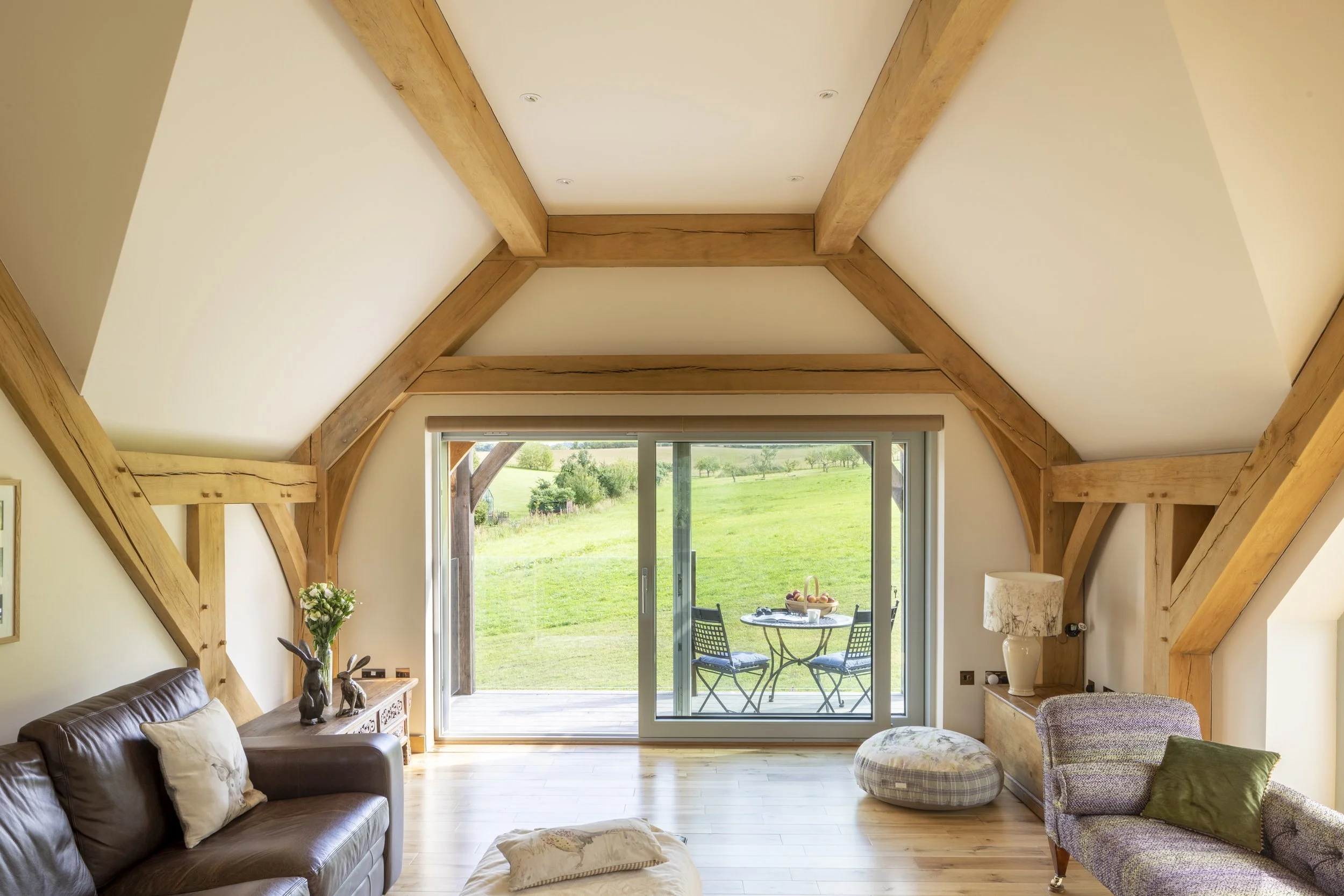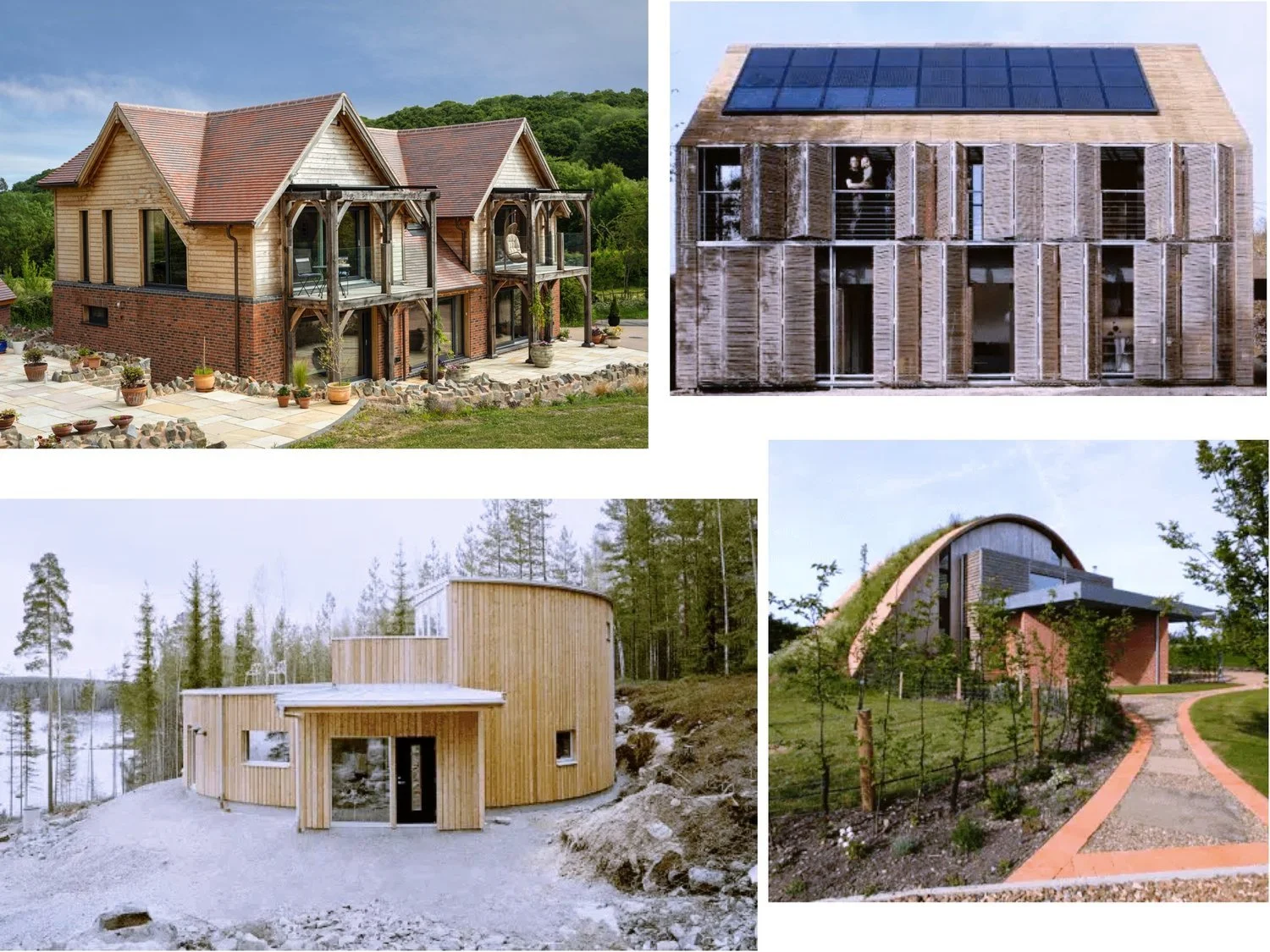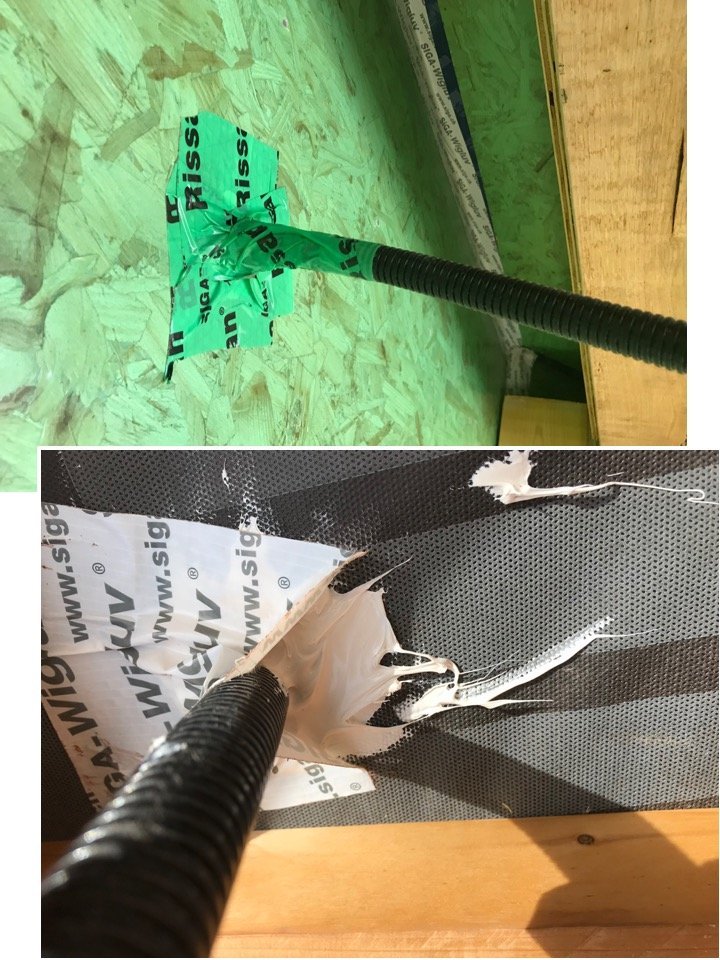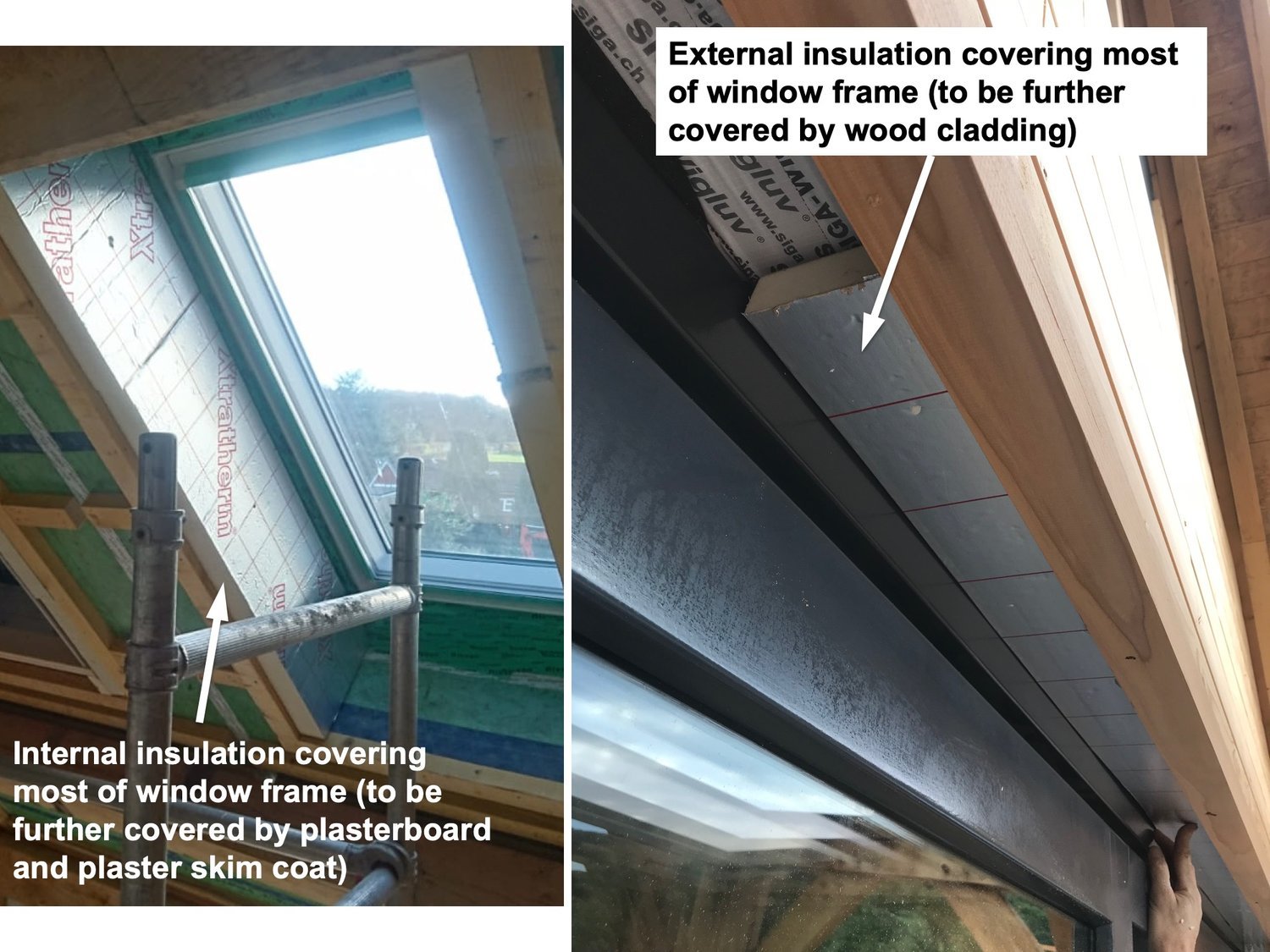What are the PROs and CONS of a passive house?
Passivhaus (passive house) buildings are some of the most energy-efficient worldwide. Designed to minimise energy use for both heating and cooling, they are also fantastically comfortable places to live all-year round. We’ve written elsewhere about our experiences of self-building and living in our certified, award-winning passive house; here we look at the advantages and disadvantages of passive houses and how much more expensive they are to build (spoiler alert: not very much).
Passive house advantages
Passive house comfort that’s unequalled
Having lived in a certified Passivhaus for five years, we’d say that the consistently extraordinarily high level of comfort throughout the house is the main reason to build/retrofit to this standard. We would certainly now not wish to move into a non-passive house.
Thermal comfort
As Passivhaus owner, Mark Tiramani, explains in the video opposite, a passive house has a near-constant temperature year-round, and there’s a wonderful sensation when coming in on a cold day of a very gentle warmth seemingly coming from everywhere. We’d add, that, similarly, on a hot summer’s day, there’s a very gentle coolness that seems to come from everywhere. This thermal comfort is found consistently throughout the house; and even if it’s -10℃ outside you can sit perfectly comfortably right up against the triple-glazed windows, which increases the usable floor space available (see also the thermal cross-section of a triple-glazed window, below right).
And in the graphs below, you can see the indoor and outdoor temperatures at Woodlands Malvern B&B throughout 2023, and during the July heatwave and December cold snap in 2022 (graphs below left and right, respectively). Despite such extremes, and throughout 2023 (as in all previous years), the indoor temperature in our passive house stays remarkably constant, whatever is going on outside.
A key characteristic of a Passivhaus is the constancy of the indoor temperature whatever the weather
No draughts
Even if it’s -10℃ outside, the inner pane of a properly-installed, good quality, triple-glazed window will be approximately the same as the room temperature. This eliminates draughts from convection currents and means you can be comfortably right up against the window even when it’s very cold outside: not a feature of double-glazing. Picture credit: My first passive house in Pennsylvania
Passive house living is also characterised by a complete absence of draughts throughout. There are two reasons for this:
the high-quality building standard of a passive house means that it has an extremely high level of airtightness (see the section entitled Comfort and indoor air quality: another benefit of Passivhaus living in another post); and
the use of properly installed triple glazing prevents convection currents because the inside pane is at approximately the same temperature as the room (see the Triple glazing section in another post).
This draught-free effect is especially noticeable on cold winter nights if guests take their time to say goodbye at an open front door: there’s no coldness felt elsewhere in the house, and the temperature at the door returns to normal within moments of closing: the house’s airtightness means that there’s no route for the cold outside air to get indoors.
Constant fresh air
The F7 (the highest grade available) inlet filter on our MVHR unit (left, above) meets the ISO ePM1 standard, filtering a minimum of 50% of particles sized 0.3-1µm (see this link for more detail about what is filtered out)
A further characteristic of the unparalleled passive house indoor environment is having 100% fresh, filtered air everywhere. Any building with a high level of airtightness requires a mechanical ventilation heat recovery (MVHR) system and this provides a constant, inaudible supply of fresh air throughout. We liken this to having a window open in every room all year round without any draughts and with minimal heat loss. The MVHR also ensures that water vapour (such as from showers and cooking), as well as smells, are very quickly removed.
The pictures opposite show the inlet (left) and exhaust (right) filters on our MVHR after six months of use. Despite living in the country, it’s remarkable how much dust and debris are kept out of the house, and how little dust there is on the exhaust air filter.
Our Passivhaus feels bright and airy all the time whether the windows are open or closed. Its peaceful stillness creates a tranquility and, despite high ceilings, also a sense of cosiness
Low dust levels, few insects
We have found our house to have remarkably low levels of dust and insects. The former is probably related to the always-on MVHR extractor ducts pulling stale air out of the house. The latter is likely due to not needing to open windows often and for several of these to be inward tilting, which seems to confuse insects who thus can’t easily find a way in.
Peace and quiet
The high levels of insulation, airtightness and double glazing also make the house remarkably quiet and peaceful. This adds substantially to the serenity, and — almost paradoxically — cosy nature of the interior environment.
Relative humidity at Woodlands in 2023. Passivhaus design enables the indoor relative humidity to stay within the ideal range most of the time as well as preventing surface and interstitial condensation
Relative humidity
The combination of airtightness and the MVHR system also mean that relative humidity is well-controlled in a passive house.
The graph opposite shows the relative humidity at Woodlands Malvern B&B throughout 2023 and, for most of the time it was within the ‘ideal range’ (see research paper at this link).
The other effects of this are that washing dries indoors very quickly.
And plants just love the environment of a passive house!
Passive houses have minute bills for heating and cooling
Passivhaus buildings are best known for having miniscule heating bills. At January 2024 electricity prices for our supplier we estimate that, including the standing charge and VAT, it costs us £129 to heat our approximately 200m² house. Each year. Below, we explain how we calculated this figure.
The bar chart below shows the monthly consumption of electricity of our heat pump between October 2019 and December 2023 (it has its own meter). The heat pump heats both domestic hot water and our heating system. (You can find out more about our heat pump in another post; space heating is provided by water heated by the heat pump flowing in pipes under just one quarter of our floor area: the three ensuite bathrooms and the hall and boot room — see more in the Keeping warm section of our Passive House Living post.)
Heat pump electricity consumption at Woodlands Malvern B&B Oct 2019 - Dec 2023
The median electricity consumption of the heat pump over this period was 108.1kWh (red dashed line in bar chart, above), with above-median consumption mostly occurring in November, December, January and February. Some very low readings, followed by higher ones, reflect changing suppliers and thus the time of the month of the meter readings, and we were away for two weeks in October 2022. (We calculated the median, being the mid-point of a range of values set out in numerical order, rather than the average because it avoids very high or very low values skewing the average; it usually provides a more accurate representation of a set of data.)
This ‘extra’ (above median) electricity consumption was likely attributable to space heating as domestic hot water heating can be assumed to be roughly the same each month. The total of all positive differences between median and actual usage throughout this 51-month period, that is, the total ‘extra’ usage, was 1720.62kWh, or 1720.62 ÷ 51 x 12 = 404.851765kWh per year.
Our supplier has estimated that we’ll use 8567kWh of electricity for all purposes in 2024 at a cost of £2733 (January 2024 prices, including standing charge and VAT), that is £0.31901482 per kWh.
Thus, at January 2024 prices, taking our averaged estimated space heating costs over the last 51 months, it has cost £0.31901482 x 404.851765 = £129.15 to heat the house annually.
We can’t identify the costs of summer cooling using our ‘cooler battery’ (described in the section Cooler battery in another post; we chose to install this, it’s not a common passive house feature) and this seems to function less often than the heating system does in winter. In any event, avoidance of over-heating is mainly achieved through the houses design and the use of blinds (see the Keeping cool section in another post about Passive house living). The cooler battery runs only using a pump to circulate the fluid in ground source heat pump’s ground array and does not require the use of the heat pump itself. We consider that the electricity consumption for summer cooling with the cooler battery is very low.
Passive houses are simple to live in
In our experience, a passive house is very easy to live in:
you can open windows any time you wish - in fact, you’ll be able to open them both earlier and later in the year than your neighbours living in non-passive houses;
a good quality MVHR system will work automatically (for example, switching itself to ‘summer bypass’ to avoid transferring heat from outgoing air to incoming when it’s warmer outside, and just needs manual boosting using a simple controller (usually sited in the kitchen or living area) if you have a lot of people around or turning down if you are away for a while;
our heating system, and our cooler battery, work automatically, using traditional-style thermostats;
we manually operate horizontal blinds over our two balconies, and on our two south-facing roof windows, in hot summer sunshine to avoid over-heating: a very simple task requiring the press of a button on a remote control;
on hot summer days opening a couple of downstairs and upstairs windows flushes out heat during the night to help the house keep cool (also called ‘Mediterranean purging’);
the MVHR unit needs its filters cleaned after six months and replaced after twelve — a very simple task described in our post on MVHR filter replacement); and
the heat pump needs servicing annually, as would most heating systems in any type of building.
There is no need to adjust thermostatic radiator valves in different rooms (there aren’t any radiators!) because the house is the same temperature everywhere (give or take just 1-2℃). There’s no need to have timers to switch heating on and off at different times: it’s roughly the same temperature throughout the whole day (see the temperature chart above).
Further, there is no need to get out a heavier duvet or an electric blanket for the winter — we use the same lightweight duvet all year round. And there’s no need for electric fans to keep cool when the weather is hot, or to experience sleepless sultry summer nights, because of the relative constancy of the indoor temperature — again, see the temperature charts above, especially that of the heatwave in July 2022.
Passive houses have consistent, predictable performance
If your passive house is designed using the Passive House Planning Package and then built with care and attention to detail — especially in achieving the airtightness standard — then you can expect your home to perform as intended for many years to come.
In the video link, opposite, you can hear Prof Wolfgang Feist, a physicist who developed the Passivhaus concept, talking about the world’s first Passivhaus, still performing as it was designed after 30+ years.
Passive houses can be designed in a variety of styles
As indicated in the pictures, left, new-build passive houses can come in a variety of designs. And the standard is applicable to retrofitting many types of existing buildings as well; we discuss making your house more passive in another post. And you can see a number of other examples of different passive house designs in this post.
Ideally, the house’s main facade should face south or south east/west, and the simpler the shape the easier it is to achieve the standard. But using the Passive House Planning Package can enable you to still achieve the standard with different orientations and with some very exciting designs and materials.
Passive houses come in many different styles. Image credit: Oak-frame Passivhaus (top left): Mark Bolton Photography. Others: Brilliant Passive Houses (that will cost pennies to heat)
Passive houses are of high quality and are more durable than traditional ones
Using the Passive House Planning Package will ensure that your passive house is designed to a very high quality and, if built so, it is likely to have a much longer life. This is primarily because of the constancy of the indoor environment, particularly the control of internal moisture and a consequential absence of surface and interstitial condensation, which should also reduce maintenance costs.
For example, we live in an oak-frame house made of ‘green’ oak (because it’s easier to work with to make the joints and beam shapes). Inevitably, the oak frame shrinks over the first few years as the wood dries and this leads to cracks in the beams (which, we think, adds to their charm) and to the beams pulling away from plasterwork. Interestingly, in our house, our Passivhaus designer and frame maker, Oakwrights, has observed that this shrinkage is much less than they usually see — likely due to the thermal and moisture stability of the indoor environment. This principle should, reasonably, apply to passive homes constructed of other materials too.
And, as noted in another post, a passive house is likely to have higher quality components, especially insulation, and windows and doors, so the house can also be expected to need less maintenance.
Passive houses have a higher resale value
There is now clear evidence that good quality, highly energy-efficient homes attract a selling price premium. For example:
research by Legal & General shows that buyers will pay 10-20% more for energy-efficient homes;
a report by Santander described home buyers being prepared to pay nearly 10% more for houses that have been retrofitted to high energy efficiency levels, and it found estate agents were reporting buyers paying 15.5% more for energy efficient homes;
a Knight Frank report identified buyers paying between 8.8% and 19.6% more for properties that had improved their EPC scores (depending on the score’s starting point);
the Halifax is reported to be finding clients paying more for homes with higher energy ratings, and
Rightmove also reports house sales showing a ‘green price premium’.
Whilst it will take a little while for a selling premium to accrue following building completion it’s good to know that your passive house will very likely make you more money when sold, as well as save you a very substantial amount in annual heating and cooling costs.
What do others say about living in a passive house?
Below, you can see some videos about people’s experiences of living in passive houses in the different climates of England, Wales, New Zealand and Australia (also comparing traditional and passive houses). These owners confirm experiencing comfort in every room; an absence of condensation; a clean, fresh, light and airy atmosphere; a lack of draughts; quietness; much smaller amounts of dust and insects indoors; and — of course — very low energy bills.
Passive house disadvantages
Passive houses have slightly higher up-front costs
The cost of your self-build or retrofit project will depend on the complexity of the design, the level of fees your architect/consultant levies, the materials you choose to build with, and building costs and other considerations due to your particular site.
The additional cost of building to the Passivhaus standard has been calculated by the Passivhaus Trust to be about 8% and to be just 0.9% for a new-build Passivhaus and 0.04% for a retrofit according to research by University College London (UCL) Estates. (We’re inclined to think that these latter two estimated extra costs may be a little optimistic.) Below, where possible, we give estimates of our own additional costs.
Principally, the additional costs of building a passive house are:
extra design time, including using the Passive House Planning Package. In our case, we estimate that this was 0.57% of the total building cost (including all other professional fees for the project, and excluding the cost of land acquisition);
higher levels of insulation compared with a less well-insulated ‘traditional’ new build;
triple-glazed windows (and, perhaps, doors), but the price difference with double-glazing is dropping and is currently likely to be only an additional 10-20%;
a mechanical ventilation heat recovery system, unless you are building a house with traditional levels of draught-proofing and are using window trickle vents. In our case, we estimate that our MVHR system cost was 1.47% of the total building cost, including MVHR design, supply and installation. (If your new-build ‘traditional’ house is constructed to a very high level of airtightness then you will also need an MVHR system);
extra airtightness tape, In our case, we estimate that this was 0.05% of the total building cost; and
we chose to have an extra air test at the first fix stage, which was 0.09% of the total building cost and, obviously, was an optional extra. (An airtightness test for a new-build home is required by the UK building regulations, although the standard required is much lower than the Passivhaus one. Having an additional one at the first-fix stage enables you to identify and correct any leaks when it’s still simple to do.)
A passive house also requires a shading strategy to minimise overheating in summer. This may be achieved with deeper eves, external blinds, other structures (we have two balconies, for example), and vegetation, such as trees. This may or may not add to the cost over a traditional, less energy-efficient property where, without such a strategy, significant summer overheating is a risk.
Importantly, there is no need to pay for Passivhaus Institut certification for your project unless you wish to have an external assurance that the design and build processes were undertaken properly, although such certification may well add value to the property when selling.
If you want certification then the cost will depend on the amount of work the assessor will have to undertake. But it’s important to note that it is possible to achieve certification without necessarily using Passivhaus Institut-certified components, which tend to be more expensive because of their much higher specification — the Passive House Planning Package will enable you to know what specification is required for individual components. (The exception to this is that we’d recommend having a Passivhaus Institut-certified MVHR unit as this guarantees a much higher level of heat recovery than some others.)
Passive houses need a builder who applies meticulous attention to detail
MVHR inlet and exhaust ducts are heavily insulated and require airtightness taping all around with additional insulation where they pass through the airtightness layer and the full depth of the house’s insulation to avoid creating a cold bridge
You do not necessarily need a builder who has built a passive house before and we did not do this. But what is most important is your building team’s attention to detail. This particularly needs to be focussed on ensuring a very high level of airtightness. For example, where the air tightness layer needs to be penetrated — for, say, cabling for satellite TV — special grommets are required which are the sealed into the airtightness layer inside and out (see pictures, right). And the specially insulated, large inlet and exhaust ducts of the MVHR will need to be sealed with airtightness tape and the surrounding area fully insulated (see pictures below). Breaching the airtightness layer otherwise should be avoided.
Special ducts with flanges/grommets on the inside (above) and outside (below) sealed with airtightness tape to allow fully sealed penetration of airtightness layer for cable penetration
Additional insulation covering most of the inside and outside of the window frames, which also sit roughly in the middle of the wall insulation helps to reduce heat loss through the frame
A further example of the need for meticulous attention to detail concerns passive house window installation. Most heat is lost from windows through their frames rather than the glass. So, instead of installing windows in the traditional way on the outermost aspect of the external walls they are ideally installed roughly in the middle of the wall insulation layer and to have extra insulation installed both inside and out all around the frame (roof windows are an exception to this — see section entitled The roof windows in another post). This is in addition to using brackets to fix the window frames rather than screws going through them, and installing a layer of expanding foam tape (such as Vitaseal) around the frame before placing it in the opening to provide additional insulation and airtightness, as well as airtightness tape inside and out all around the frame (see pictures right, and below).
Surrounding the window and door frames we used an expanding foam tape (Vitaseal) to help with insulation and airtightness. In addition, airtightness tape was applied inside and out between the window and door frames and the house’s structure
None of this attention to detail is particularly difficult, but does require a building team that is willing to do things a little differently to traditional ways and for everyone on the main team, and external contractors, to be fully engaged in this way of working.
Adding an extension to a passive house is more complicated
Because the insulation under the floor and in the walls and roof needs to be continuous, and the airtightness layer needs to be maintained everywhere, extending a passive house can be a bit more complex than it is in a traditional house. Also, because the relationship between internal volume and floor area affects achieving the the Passivhaus standard, you’ll almost certainly need to employ an architect/consultant who knows how to use the Passive House Planning Package at the design stage if you want to maintain passive house performance. You will also need a builder who will apply meticulous attention to detail, as referred to above.
But this is only likely to be an issue if you are buying an existing passive house with a view to extending it. If you are self-building a new home, or retrofitting, then make sure your plans are as future-proofed as possible.
You’ll have unused bedding and clothing if you choose a passive house
You’ll no longer need a heavier duvet for winter; we use the same very lightweight duvet all year round. And you will only need thick jumpers and the like when outdoors or visiting friends’ houses in the colder months. You’ll also no longer need an electric blanket, or slippers if walking on bathroom or kitchen tiles in winter. This is because of the constancy of the temperature in a passive house with all surfaces (such as floor tiles) feeling comfortable all of the time.
A further ‘problem’ of passive house living is that you can’t tell what you need to wear just by looking out of the window: because it’s always warm and comfortable inside a sunny mid-winter day seen through a triple-glazed window may make you think that you only need a tee-shirt — until you open the door to go out…
You’ll be keen to get back home when staying in others’ houses and in hotels
It’s good to stay with friends and relatives and to go away now and then. But the unique high-quality indoor environment of your passive house (especially on hot summer nights and cold winter days) will make you want to get back to the high level of year-round comfort of your home all the sooner. Living in a passive house rather spoils you — and why not! — and you’ll probably feel much less need to get away.
Is a passive house for you?
Building or retrofitting to the Passivhaus standard does cost a bit more upfront, but it’s important to consider:
that passive houses can save up to 90% on heating and cooling costs compared to average UK homes (75% compared to those built to current Building Regulation standards);
that there is, increasingly, a price premium when selling an ‘eco’ home; and
what do you think is likely to happen to energy prices over the coming years for both heating and cooling — building to the Passivhaus standard will offset these substantially.
Your view of the balance between the slightly higher up-front cost and the very much lower heating and cooling bills of a passive house will depend on your personal circumstances, and how long you anticipate living in one. There is also the consideration that in a passive house, you’ll be making a contribution towards saving energy and reducing CO₂ emissions because of your substantially reduced energy use; whilst small in the greater scheme of things, your carbon footprint will still be lower than if living in a traditional property.
But it’s also important to also take account of the exceptionally high level of comfort throughout a passive house — for us, this is the most important reason to live in one.
Experience the Passivhaus difference
You can find out for yourself what the high levels of comfort and freshness in a passive house are like at Woodlands Malvern B&B. Like Goldilocks, we think you’ll find that it’s ‘just right’. We’ll also be pleased to share with you how we found self-building a passive house and what it’s like to live in one.


